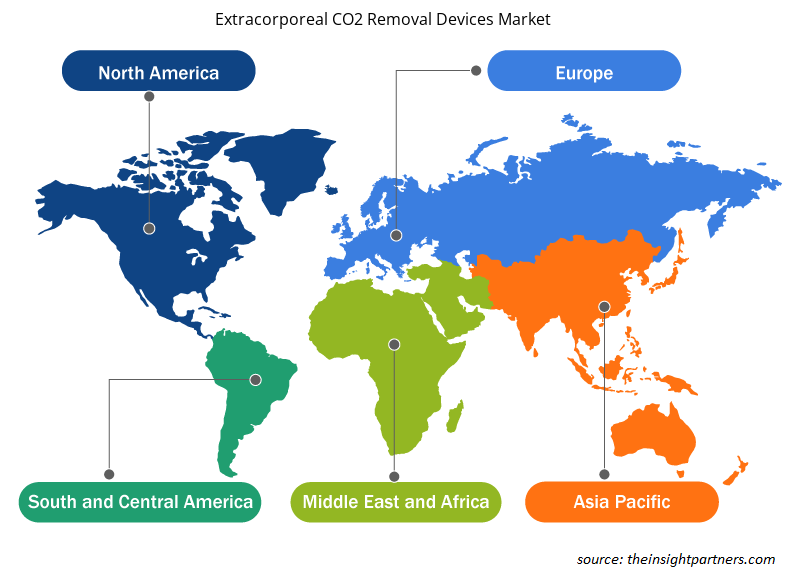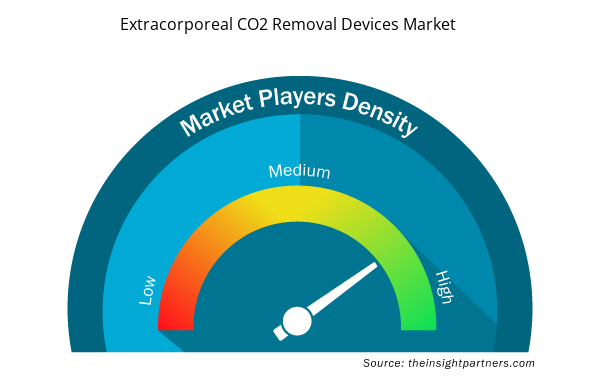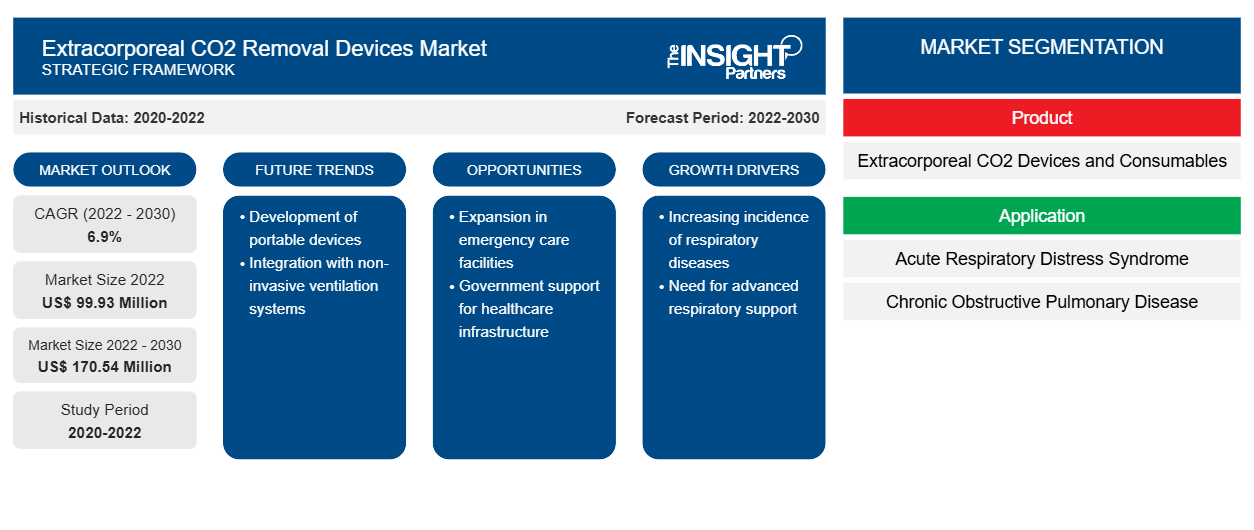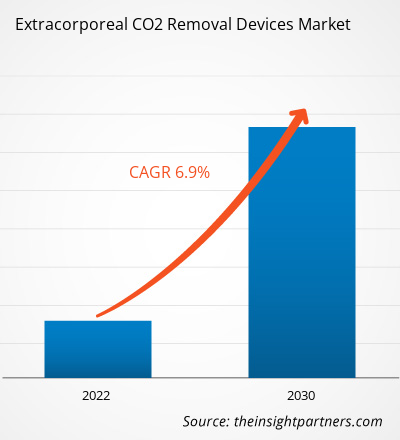[研究报告] 体外二氧化碳去除装置市场预计将从 2022 年的 9993 万美元增长到 2030 年的 1.7054 亿美元;预计该市场在 2022-2030 年期间的复合年增长率为 6.9%。
市场洞察和分析师观点:
慢性阻塞性肺病 (COPD) 病例的增加和老年人口的增长等因素推动了体外 CO2 去除设备市场的增长。然而,与体外 CO2 去除设备相关的严格规定阻碍了市场的增长。
体外二氧化碳去除装置安全、有效且可行。在临床情况下,建议使用体外二氧化碳去除装置进行呼吸支持,这可能有助于解决 COPD 和急性呼吸窘迫综合征的恶化。一些制造商专注于开发技术先进和创新的体外二氧化碳去除装置并加强其市场地位。此外,越来越多易患 COPD 的老年人被插入体外二氧化碳去除装置以提高他们的存活率。因此,肺阻塞性疾病发病率的增加是导致体外二氧化碳去除装置市场规模不断增长的因素之一。相反,使用体外二氧化碳去除装置存在感染、低氧血症或血栓形成的风险,因为循环系统的血流受限会导致严重的健康问题并对市场扩张构成长期挑战。
增长动力:
慢性阻塞性肺病病例增加 推动体外二氧化碳去除装置市场
根据 2019 年的疾病负担研究,全球记录了 2.123 亿例 COPD 病例和 330 万例 COPD 相关死亡病例。COPD 等呼吸系统疾病的主要原因之一是空气污染日益严重。此外,经济合作与发展组织 (OECD) 表示,到 2050 年,全球温室气体排放量预计将激增约 50%,原因是二氧化碳排放量将增加到 70%。此外,它估计,到 2050 年,大气中温室气体的浓度可能达到 685 ppm 二氧化碳当量,这将导致平均气温比工业化前水平上升 3-6°C。
2021 年 1 月,根据发表在 PLoS ONE 杂志上的研究,法国约有 260 万人患有 COPD。到 2025 年,这一数字预计将上升到 280 万。根据国家卫生科学局发布的 2022 年统计数据,2020-21 年,英格兰约有 117 万人被诊断出患有 COPD,占总人口的 1.9%。根据世界卫生组织的数据,COPD 被认为是全球第三大死亡原因,2022 年造成约 320 万人死亡。此外,根据美国肺脏协会的数据,美国每年有超过 1100 万人被诊断出患有 COPD。因此,人口中 COPD 的高负担增加了对体外 CO2 去除装置的需求,以促进血液流动和有效的气体交换,从而推动体外 CO2 去除装置市场的增长。
定制此报告以满足您的需求
您可以免费定制任何报告,包括本报告的部分内容、国家级分析、Excel 数据包,以及为初创企业和大学提供优惠和折扣
- 获取此报告的关键市场趋势。这个免费样品将包括数据分析,从市场趋势到估计和预测。
报告细分和范围:
“体外二氧化碳去除装置市场分析”是通过考虑以下几个部分进行的:产品、应用和最终用户。
节段分析:
根据应用,体外 CO2 去除装置市场细分为急性呼吸窘迫综合征、慢性阻塞性肺病和其他疾病。慢性阻塞性肺病领域在 2022 年占据了最大的市场份额。预计急性呼吸窘迫综合征领域在预测期内的复合年增长率最高,为 7.7%。人们对 ARDS 及其早期发现的认识不断提高,导致更多患者得到诊断和治疗,从而导致对专为 ARDS 管理而设计的体外 CO2 去除装置的需求增加。因此,医疗保健提供者对将体外 CO2 去除装置纳入其 ARDS 治疗方案变得更加有信心。
体外二氧化碳去除装置可以降低呼吸频率和潮气量,从而延长呼气时间,更好地适应呼吸系统的高呼气时间常数。根据英国肺脏协会的数据,英国约有 120 万人患有 COPD。因此,COPD 患病率的不断上升预计将加速全球体外二氧化碳去除装置市场的发展。
体外二氧化碳去除设备市场按产品分为体外二氧化碳设备和耗材。体外二氧化碳设备部分在 2022 年占据了更大的市场份额。预计耗材部分在预测期内的复合年增长率将达到 7.6%。由于技术简化,体外二氧化碳去除装置所需的人员和物流较少,从而增加了患者的偏好。这使得体外二氧化碳去除装置领域巩固了其市场地位。
体外二氧化碳去除过程需要为每位患者提供一套全新的耗材,因此各种 COPD 和 ARDS 相关程序对耗材的需求很高。因此,预计体外二氧化碳去除设备耗材市场在预测期内将继续增长。
根据最终用户,市场分为医院和诊所、门诊手术中心和其他。医院和诊所部门在 2022 年占据了体外 CO2 去除设备最大的市场份额,预计在预测期内将录得 7.4% 的最高复合年增长率。医院,尤其是那些拥有专门重症监护病房 (ICU) 和呼吸设施的医院,配备了护理病情最严重的患者的设备。此外,医院通常拥有多学科的医疗专业人员团队,包括肺病专家、重症监护医生、呼吸治疗师和灌注师,他们共同治疗有复杂呼吸需求的患者。这种专业知识对于安全有效地使用 ECCO2R 设备至关重要。
不断进步的技术加速体外二氧化碳去除装置市场的发展
较小的体外二氧化碳去除装置对患者来说创伤更小,也更舒适。它们通常需要较小的血管通路,从而降低并发症的风险。由于患者不再被大型、无法移动的装置束缚,他们可以体验到更大的活动性和舒适度,从而提高整个治疗质量。膜技术的进步显著提高了体外二氧化碳去除装置的有效性和功效。它们选择性地允许二氧化碳扩散,同时保留重要的血液成分,如红细胞和蛋白质。这种选择性将溶血和其他血液相关并发症的风险降至最低。
由于老年人健康状况恶化,他们更需要维持生活质量,体外二氧化碳去除装置在提供侵入性更小、更温和的呼吸支持方面发挥着重要作用。体外二氧化碳去除 (ECCO2R) 的技术进步推动了更用户友好和便携设备的开发。随着其益处越来越受到认可,ECCO2R 越来越多地被纳入老年人的治疗计划。因此,不断增长的技术进步可能会在未来几年带来新的体外二氧化碳去除装置市场趋势。
区域分析:
体外二氧化碳去除装置市场报告的范围涉及北美、欧洲、亚太、南美和中美以及中东和非洲。
2022 年,北美占据了体外二氧化碳去除设备最大的市场份额。该地区市场的增长得益于医疗基础设施的改善和体外二氧化碳去除设备的广泛采用,尤其是在美国和加拿大的 COVID-19 大流行期间。新技术的早期采用和 ARDS 和 COPD 的大量患者群体预计将加速该地区市场的增长。慢性呼吸系统疾病发病率的增加以及对安全快速的微创呼吸机的偏好预计将进一步加速预测期内体外二氧化碳去除设备市场的增长。
欧洲体外二氧化碳去除设备市场预计将占据全球第二大市场份额。这是由于该地区对医疗保健设备的需求不断增长,以及呼吸衰竭等慢性病的发病率不断上升。此外,优惠的报销政策、政府对长期医疗保健的不断增加的投资以及医疗保健研究基础设施的不断增长,正在提高体外二氧化碳去除设备的使用率。
预计亚太地区体外二氧化碳去除设备市场在预测期内将实现最快的 7.3% 增长率。增长的原因是患者数量庞大、人们对急性呼吸衰竭的认识不断提高以及印度和日本等发展中国家政府医疗保健支出的增加。此外,跨国公司期待在中国等发展中国家进行投资,从而推动该地区的市场增长。
体外二氧化碳去除装置市场区域洞察
Insight Partners 的分析师已详尽解释了预测期内影响体外二氧化碳去除设备市场的区域趋势和因素。本节还讨论了北美、欧洲、亚太地区、中东和非洲以及南美和中美洲的体外二氧化碳去除设备市场细分和地理位置。

- 获取体外二氧化碳去除装置市场的区域特定数据
体外二氧化碳去除装置市场报告范围
| 报告属性 | 细节 |
|---|---|
| 2022 年市场规模 | 9993万美元 |
| 2030 年的市场规模 | 1.7054亿美元 |
| 全球复合年增长率(2022 - 2030 年) | 6.9% |
| 史料 | 2020-2022 |
| 预测期 | 2022-2030 |
| 涵盖的领域 | 按产品
|
| 覆盖地区和国家 | 北美
|
| 市场领导者和主要公司简介 |
|
体外二氧化碳去除装置市场参与者密度:了解其对业务动态的影响
体外二氧化碳去除设备市场正在快速增长,这得益于终端用户需求的不断增长,这些需求源于消费者偏好的不断变化、技术进步以及对产品优势的认识不断提高等因素。随着需求的增加,企业正在扩大其产品范围,进行创新以满足消费者的需求,并利用新兴趋势,从而进一步推动市场增长。
市场参与者密度是指在特定市场或行业内运营的企业或公司的分布情况。它表明在给定市场空间中,相对于其规模或总市场价值,有多少竞争对手(市场参与者)存在。
在体外二氧化碳去除装置市场运营的主要公司有:
- 洁廷
- ALung Technologies, Inc.
- 埃斯托
- 诺瓦隆有限公司
- 血液净化设备
免责声明:上面列出的公司没有按照任何特定顺序排列。

- 获取体外二氧化碳去除设备市场主要参与者的概述
行业发展和未来机遇:
体外二氧化碳去除设备市场预测可以帮助该市场的利益相关者规划其增长战略。以下列出了市场上领先企业的一些战略发展:
- 2022 年 10 月,ALung Technologies 评估了使用 Hemolung 呼吸辅助系统 (RAS) 进行低流量体外二氧化碳去除 (ECCO2R) 作为有创机械通气的替代或辅助手段,用于因慢性阻塞性肺病 (COPD) 急性加重而需要呼吸支持的患者。
- 2022 年 3 月,美国呼吸健康技术公司 Respira Labs 推出了 Sylvee。这款由人工智能驱动的可穿戴肺监测器使用声学共振来评估肺功能并识别肺容量波动。它可以帮助检测和治疗慢性阻塞性肺病、哮喘和 COVID-19。
- 2021年5月,ALung Technologies, Inc.的下一代Hemolung RAS体外二氧化碳去除系统获得FDA批准,旨在为急性呼吸衰竭患者提供呼吸支持。
- 2020年5月,ALung Technologies, Inc.宣布对名为Hemolung RAS的下一代人工肺进行商业开发。
竞争格局和重点公司:
Getinge、ALung Technologies, Inc.、Estor、NovaLung GmbH、Hemodec、Baxter Healthcare、Eurosets、LivaNova、Medtronic 和 Xenios AG 是体外二氧化碳去除设备市场报告中介绍的知名公司。这些公司专注于开发新技术、升级现有产品并扩大其地理覆盖范围,以满足全球日益增长的消费者需求。
- 历史分析(2 年)、基准年、预测(7 年)及复合年增长率
- PEST 和 SWOT 分析
- 市场规模价值/数量 - 全球、区域、国家
- 行业和竞争格局
- Excel 数据集



Report Coverage
Revenue forecast, Company Analysis, Industry landscape, Growth factors, and Trends

Segment Covered
This text is related
to segments covered.

Regional Scope
North America, Europe, Asia Pacific, Middle East & Africa, South & Central America

Country Scope
This text is related
to country scope.
常见问题
The factors driving the growth of the extracorporeal CO2 removal devices market include the increasing cases of chronic obstructive pulmonary diseases (COPD) and growing geriatric population.
The extracorporeal CO2 removal devices market majorly consists of the players such as Getinge, ALung Technologies, Inc.; Estor, NovaLung GmbH, Hemodec, Baxter Healthcare, Eurosets, LivaNova, Medtronic, and Xenios AG.
Extracorporeal CO2 removal devices are an efficient therapy for patients with hypercapnic respiratory failure. They can enable doctors and healthcare professionals to improve lung protective ventilation. Extracorporeal CO2 removal devices can remove enough CO2 to reduce alveolar minute ventilation by 50%, significantly reducing the partial pressure of carbon dioxide (PaCO2). Therefore, various advantages of extracorporeal CO2 removal devices are expected to increase the overall market development.
The global extracorporeal CO2 removal devices market, based on product is bifurcated into extracorporeal CO2 devices and consumables. The extracorporeal CO2 devices segment held a larger market share in 2022. The consumables segment is anticipated to register a higher CAGR of 7.6% during the forecast period. Based on application, the market is segmented into acute respiratory distress syndrome, chronic obstructive pulmonary disease, and others. The chronic obstructive pulmonary disease segment held the largest market share in 2022. The acute respiratory distress syndrome segment is anticipated to register the highest CAGR of 7.7% during 2022–2030. In terms of end user, the extracorporeal CO2 removal devices market is segmented into hospitals and clinics, ambulatory surgical centers, and others. The hospitals and clinics segment held the largest extracorporeal CO2 removal devices market share in 2022 and is anticipated to register the highest CAGR of 7.4% during 2022–2030.
The hyperbaric oxygen therapy market was valued at US$ 99.93 million in 2022.
The hyperbaric oxygen therapy market is expected to be valued at US$ 170.54 million in 2030.
Trends and growth analysis reports related to Life Sciences : READ MORE..
The List of Companies - Extracorporeal CO2 Removal Devices Market
- Getinge
- ALung Technologies, Inc.
- Estor
- NovaLung GmbH
- Hemodec
- Baxter Healthcare
- Eurosets
- LivaNova
- Medtronic
- Xenios AG
The Insight Partners performs research in 4 major stages: Data Collection & Secondary Research, Primary Research, Data Analysis and Data Triangulation & Final Review.
- Data Collection and Secondary Research:
As a market research and consulting firm operating from a decade, we have published and advised several client across the globe. First step for any study will start with an assessment of currently available data and insights from existing reports. Further, historical and current market information is collected from Investor Presentations, Annual Reports, SEC Filings, etc., and other information related to company’s performance and market positioning are gathered from Paid Databases (Factiva, Hoovers, and Reuters) and various other publications available in public domain.
Several associations trade associates, technical forums, institutes, societies and organization are accessed to gain technical as well as market related insights through their publications such as research papers, blogs and press releases related to the studies are referred to get cues about the market. Further, white papers, journals, magazines, and other news articles published in last 3 years are scrutinized and analyzed to understand the current market trends.
- Primary Research:
The primarily interview analysis comprise of data obtained from industry participants interview and answers to survey questions gathered by in-house primary team.
For primary research, interviews are conducted with industry experts/CEOs/Marketing Managers/VPs/Subject Matter Experts from both demand and supply side to get a 360-degree view of the market. The primary team conducts several interviews based on the complexity of the markets to understand the various market trends and dynamics which makes research more credible and precise.
A typical research interview fulfils the following functions:
- Provides first-hand information on the market size, market trends, growth trends, competitive landscape, and outlook
- Validates and strengthens in-house secondary research findings
- Develops the analysis team’s expertise and market understanding
Primary research involves email interactions and telephone interviews for each market, category, segment, and sub-segment across geographies. The participants who typically take part in such a process include, but are not limited to:
- Industry participants: VPs, business development managers, market intelligence managers and national sales managers
- Outside experts: Valuation experts, research analysts and key opinion leaders specializing in the electronics and semiconductor industry.
Below is the breakup of our primary respondents by company, designation, and region:

Once we receive the confirmation from primary research sources or primary respondents, we finalize the base year market estimation and forecast the data as per the macroeconomic and microeconomic factors assessed during data collection.
- Data Analysis:
Once data is validated through both secondary as well as primary respondents, we finalize the market estimations by hypothesis formulation and factor analysis at regional and country level.
- Macro-Economic Factor Analysis:
We analyse macroeconomic indicators such the gross domestic product (GDP), increase in the demand for goods and services across industries, technological advancement, regional economic growth, governmental policies, the influence of COVID-19, PEST analysis, and other aspects. This analysis aids in setting benchmarks for various nations/regions and approximating market splits. Additionally, the general trend of the aforementioned components aid in determining the market's development possibilities.
- Country Level Data:
Various factors that are especially aligned to the country are taken into account to determine the market size for a certain area and country, including the presence of vendors, such as headquarters and offices, the country's GDP, demand patterns, and industry growth. To comprehend the market dynamics for the nation, a number of growth variables, inhibitors, application areas, and current market trends are researched. The aforementioned elements aid in determining the country's overall market's growth potential.
- Company Profile:
The “Table of Contents” is formulated by listing and analyzing more than 25 - 30 companies operating in the market ecosystem across geographies. However, we profile only 10 companies as a standard practice in our syndicate reports. These 10 companies comprise leading, emerging, and regional players. Nonetheless, our analysis is not restricted to the 10 listed companies, we also analyze other companies present in the market to develop a holistic view and understand the prevailing trends. The “Company Profiles” section in the report covers key facts, business description, products & services, financial information, SWOT analysis, and key developments. The financial information presented is extracted from the annual reports and official documents of the publicly listed companies. Upon collecting the information for the sections of respective companies, we verify them via various primary sources and then compile the data in respective company profiles. The company level information helps us in deriving the base number as well as in forecasting the market size.
- Developing Base Number:
Aggregation of sales statistics (2020-2022) and macro-economic factor, and other secondary and primary research insights are utilized to arrive at base number and related market shares for 2022. The data gaps are identified in this step and relevant market data is analyzed, collected from paid primary interviews or databases. On finalizing the base year market size, forecasts are developed on the basis of macro-economic, industry and market growth factors and company level analysis.
- Data Triangulation and Final Review:
The market findings and base year market size calculations are validated from supply as well as demand side. Demand side validations are based on macro-economic factor analysis and benchmarks for respective regions and countries. In case of supply side validations, revenues of major companies are estimated (in case not available) based on industry benchmark, approximate number of employees, product portfolio, and primary interviews revenues are gathered. Further revenue from target product/service segment is assessed to avoid overshooting of market statistics. In case of heavy deviations between supply and demand side values, all thes steps are repeated to achieve synchronization.
We follow an iterative model, wherein we share our research findings with Subject Matter Experts (SME’s) and Key Opinion Leaders (KOLs) until consensus view of the market is not formulated – this model negates any drastic deviation in the opinions of experts. Only validated and universally acceptable research findings are quoted in our reports.
We have important check points that we use to validate our research findings – which we call – data triangulation, where we validate the information, we generate from secondary sources with primary interviews and then we re-validate with our internal data bases and Subject matter experts. This comprehensive model enables us to deliver high quality, reliable data in shortest possible time.


 获取此报告的免费样本
获取此报告的免费样本